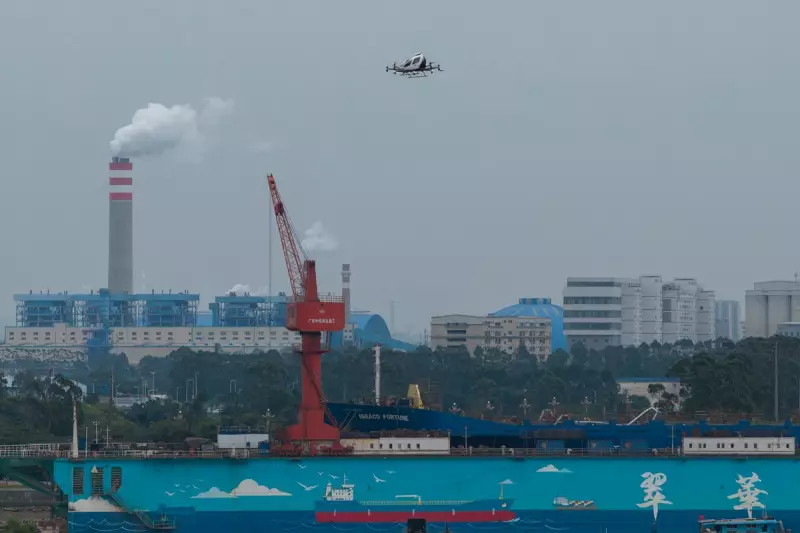
China's Sky-High Ambitions Meet Reality
On the outskirts of Guangzhou, an unmanned, oval-shaped craft from EHang hovers noisily over a riverside innovation zone, a tangible piece of a future once confined to science fiction. This trial of a mini-flying taxi represents the vanguard of China's push into the low-altitude economy—business activities in airspace below 1,000 metres.
In the nearby megacity of Shenzhen, this future is already a novelty for tourists. Polish visitor Karolina Trzciańska and her friends recently experienced it firsthand, ordering bubble tea via their phones simply to watch a drone buzz through the drizzle to deliver their drinks. "This is the first time I’m seeing something like this, so it was super fun," she remarked.
The Economic Potential and The Pioneers
This sector is expanding rapidly with significant government backing. In 2023, the low-altitude economy generated a business turnover of 506 billion yuan (£56 billion), accounting for approximately 0.4% of China's total economic output. The ambitions, however, soar much higher. Zhang Xiaolan, a researcher at the State Information Center, projects this figure will skyrocket to 3.5 trillion yuan (£387 billion) by 2035.
Guangdong province, home to drone behemoth DJI which commands an estimated 70% of the global commercial drone market, is the undisputed leader. It is followed by the wealthy eastern coastal provinces of Jiangsu and Zhejiang. The region is a hub for innovation, hosting major players like EHang, the drone logistics arm of SF Express (Phoenix Wings), and XPENG's flying car unit, ARIDGE.
Local governments are actively fuelling this growth. Shenzhen has launched a 15-million-yuan (£1.66 million) incentive for companies that secure certifications for passenger eVTOLs (electric vertical take-off and landing vehicles). In a landmark move, China’s Civil Aviation Administration has granted EHang certificates to begin commercial passenger services with its pilotless aircraft, which can reach speeds of 130 kph and has a maximum range of 30 kilometres.
EHang's vice president, He Tianxing, envisions starting with aerial sightseeing services. The company has been building takeoff and landing sites in 20 Chinese cities and He foresees multi-route networks becoming a reality within five years, potentially using the rooftops of malls and schools as terminals. "It can’t just be a research product, nor an engineer’s toy," he stated.
Navigating Turbulence: Batteries, Accidents, and Airspace
Despite the optimism, the sector's ascent is not without significant challenges. Guo Liming, co-founder of Shenzhen-based Skyevtol, identifies battery limitations as the biggest hurdle. His company's single-seat eVTOL, priced around $100,000, can only fly for 20 to 30 minutes before requiring a charge.
Safety concerns were highlighted in September when two of XPENG's eVTOL aircraft collided after a rehearsal, with one catching fire upon landing. Although no one was injured, the incident prompted another exhibition to cancel its flying demonstrations a week later.
Perhaps the most formidable obstacle is strict airspace control. The military commands most Chinese airspace, creating a complex approval process. Frank Zhou, managing director at GBA Low Altitude Technology Co., notes that while China leads in drone technology, policy constraints mean overseas markets might be more promising. "Perhaps for some Southeast Asian countries, if I introduce these applications to them, their demand could explode," he suggested.
According to researcher Zhang Xiaolan, less than one-third of China's low-altitude airspace was accessible for general aviation in 2023, and the number of registered aerodromes was just a tenth of those in the United States.
The Road Ahead: A Treacherous Path to a Bright Future
Chinese policymakers are aware of the gaps and are taking action. The military has pledged to simplify approval procedures in Shenzhen and five other provinces. Proposed revisions to the civil aviation law also include a new chapter dedicated to developing low-altitude activities.
Analysts like Gary Ng, a senior economist at Natixis, expect meaningful progress toward commercialisation around 2030, with passenger-carrying eVTOLs for tourism likely preceding flying taxi services. Chen Wen-hua, director at the Hong Kong Polytechnic University’s Research Centre for Low Altitude Economy, points to China's key advantage: the Communist Party's ability to mobilise regulators, industry, and universities towards a single goal.
However, he cautions that the pace of adoption will ultimately depend on technological development, safety, and public acceptance. "The future for the low altitude economy is bright," Chen said, adding a crucial caveat: "however, the road leading to that bright future might be treacherous."





